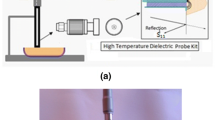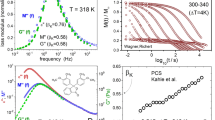Abstract
The dielectric relaxation phenomena of rigid polar liquid molecules chloral and ethyltrichloroacetate (j) in benzene, n-hexane and n-heptane (i) under 4.2, 9.8 and 24.6 GHz electric fields at 30°C are studied to show the possible existence of double relaxation times τ 2 and τ 1 for rotations of the whole and the flexible parts of molecules. The probability of showing double relaxation is more in aliphatic solvents indicating their nonrigidity. The symmetric and asymmetric distribution parameters γ and δ are obtained from X ′ ij /X 0ij and X ″ ij /X 0ij and w j →0 where X ′ ij and X ″ ij are real and imaginary parts of the complex orientational susceptibility X * i and X 0ij is the low frequency susceptibility which is real. X ij ’s are involved with the measured dielectric relative permittivities ε ′ ij , ε ″ in , ε 0ij and ε ∞ij of solutions. The theoretical weighted contributions c 1 and c 2 towards dielectric dispersions by Fröhlich’s method are compared with the experimental ones obtained from the graphical variation of X ′ ij /X 0ij and X ″ ij /X 0ij with weight fractions w j ’s at w j → 0. The measured dipole moments μ 2 and μ 1 of the whole and the flexible part of a polar molecule in terms of the linear coefficients β’s of X ′ ij ’s with w j ’s and the estimated τ 2 and τ 1 reveal their associations with aliphatic solvents. The theoretical dipole moments μ theo’s from the available bond angles and bond moments of the substituent polar groups of the molecules with the estimated μ’s suggest the mesomeric, inductive and electromeric effects in them under GHz electric field.
Similar content being viewed by others
References
A K Sharma, D R Sharma and D S Gill, J. Phys. D18, 1199 (1985)
A Sharma and D R Sharma, J. Phys. Soc. Jpn. 61, 1049 (1992)
K S Cole and R H Cole, J. Chem. Phys. 9, 341 (1941)
D W Davidson and R H Cole, J. Chem. Phys. 19, 1484 (1951)
K V Gopalakrishna, Trans. Faraday Soc. 53, 767 (1957)
U Saha, S K Sit, R C Basak and S Acharyya, J. Phys. D27, 596 (1994)
S K Srivastava and S L Srivastava, Indian J. Pure Appl. Phys. 13, 179 (1975)
A D Franklin, W M Heston, E J Hennelly and C P Smyth, J. Am. Chem. Soc. 72, 3447 (1950)
K Dutta, R C Basak, S K Sit and S Acharyya, J. Molecular Liquids 88, 229 (2000)
A K Jonscher, Physics of dielectric solids, invited papers edited by C H L Goodman (1980) p. 7
A Budo, Phys. Z. 39, 706 (1938)
K Bergmann, D M Roberti and C P Smyth, J. Phys. Chem. 64, 665 (1960)
A Mansing and P Kumar, J. Phys. Chem. 69, 4197 (1965)
H Fröhlich, Theory of dielectrics (Oxford University Press, Oxford, 1949) p. 94
J Bhattacharyya, A Hasan, S B Roy and G S Kastha, J. Phys. Soc. Jpn. 28, 204 (1970)
K Higasi, Y Koga and M Nakamura, Bull. Chem. Soc. Jpn. 44, 988 (1971)
S K Sit, R C Basak, U Saha and S Acharyya, J. Phys. D27, 2194 (1994)
S K Sit and S Acharyya, Indian J. Phys. B70, 19 (1996)
S K Sit, N Ghosh and S Acharyya, Indian J. Pure Appl. Phys. 35, 329 (1997)
J G Powles, J. Molecular Liquids 56, 35 (1993)
C P Smyth, Dielectric behaviour and structure (Mc Graw Hill, 1955) p. 140
N Ghosh, S K Sit, A K Bothra and S Acharyya, J. Phys. 34, 379 (2001)
K Dutta, S K Sit and S Acharyya, J. Molecular Liquids 92, 263 (2001)
H D Purohit, H S Sharma and A D Vyas, Indian J. Pure Appl. Phys. 12, 273 (1974)
S N Sen and R Ghosh, Indian J. Pure Appl. Phys. 10, 701 (1972)
S Chandra and J Prakash, J. Phys. Soc. Jpn. 35, 876 (1975)
L Glasser, J Crossley and C P Smyth, J. Chem. Phys. 57, 3977 (1972)
R J Sengwa and K Kaur, Indian J. Pure Appl. Phys. 37, 469 (1999)
Author information
Authors and Affiliations
Rights and permissions
About this article
Cite this article
Dutta, K., Sit, S. & Acharyya, S. Dielectric relaxation phenomena of rigid polar liquid molecules under giga hertz electric field. Pramana - J Phys 57, 775–793 (2001). https://doi.org/10.1007/s12043-001-0028-6
Received:
Revised:
Issue Date:
DOI: https://doi.org/10.1007/s12043-001-0028-6




